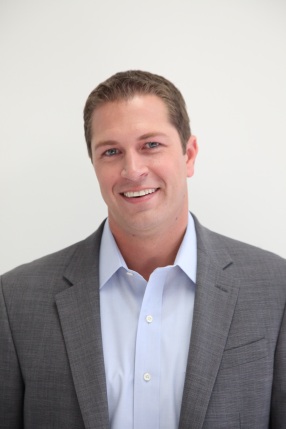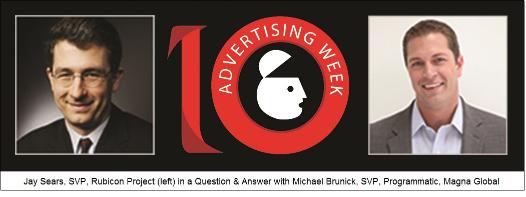Agency Trading Desks: Automating Direct Orders? Questions & Answers with Michael Brunick of Magna Global - Jay Sears

This is the second of a five-part series run by Jay Sears of the Rubicon Project at MediaBizBloggers.com leading up to a live session with the global heads of the agency trading desks at the New York Times Center on Thursday, September 26, 2013 at 11am during Advertising Week in New York.
Today we feature Sears' second Q&A in the series, this one with Interpublic and their MAGNA Global trading desk (you can also read last week's with Paul Dolan of Xaxis.)
Your Name: Michael Brunick
Your Company: Magna Global
Your Title: SVP, Programmatic
What Flavor Ice Cream Best Describes Your Management Style: Salted Caramel
SEARS: On average—out of each $1.00 spent on media (all media, not just digital) by one of your advertisers, how much today is spent on automated or programmatic channels?
BRUNICK: $0.10. I think we are right at the bottom of the hockey stick, and are about to see tremendous growth in the adoption of both Programmatic and automated investment.
What was this number two years ago, in 2011? $0.05
What will this number be two years from now, in 2015? $0.50
SEARS: Describe how most media (all media, digital + non-digital, non-programmatic media) is bought and sold today.
BRUNICK: The basic flow is: Research/Pre-PlanningàPlanningàBuyingàTraffickingàReportingàOptimizationàBilling/Reconciliation. Tools/technologies are used in virtually every step along the way, but many of the tools don't talk to each other or aren't as connected as they could or should be. There are still tons of opportunities to drive further automation within media workflow.
SEARS: Tell us the about Magna Global:
BRUNICK: Magna Global is the strategic media investment unit within Mediabrands. We are focused on delivering optimal investment strategies for our clients, and delivering best-in-class programmatic, negotiation and data-driven solutions to our partner agencies.
PLEASE TELL US:
· Overall managed budget (media spend) for your trading desk, expected 2013 GLOBAL:
o BRUNICK: We don't disclose billings or revenue
· Percentage increase, managed budget (media spend) 2012 vs. expected 2013 [Global only #]:
o BRUNICK: 40%+ growth in the US, 100%+ growth outside the US in 2013
· How many employees globally
o BRUNICK: Worldwide: 200+
SEARS: What are Magna Global's three biggest initiatives for the second half, 2013?
BRUNICK: 1) Integration of Exchange/RTB and Programmatic Guaranteed; 2) Evolution of our AMP data platform; 3) Implementation of the Magna Media Consortium
SEARS: By 2015, what percentage of total media spend across your holding company will be programmatic?
BRUNICK: Mediabrands is working towards 50% automation within three years – that means 50% of our billings will be executed via an automated workflow by the end of 2015. There are several components of overall automation – Programmatic is one of those components – and we are currently focused on maxing out Programmatic's contribution to the overall automation agenda. As we move through 2014 and 2015, several other initiatives will come online that will drive further automation.
SEARS: To reach a higher adoption of direct deal automation and use of the programmatic channel, what are the major impediments to overcome? Rank these in numerical order:
BRUNICK:
_1_ Operational or workforce issues inside the holding companies or operating agencies
_4_ Premium (direct deal) inventory availability via programmatic
_3_ Lack of proper ad technology (NOTE STRIKETHROUGH)
_5_ Alignment of agency compensation models
_2_ Other: __Client Readiness___
We are talking about a fundamental change in the process by which work is executed in the media industry – that is change on the agency-side, the sell-side and the client-side. All of those constituents are used to a certain amount of control (or perceived control) inherent in today's process, and getting all parties used to the dynamics of a market-driven model does take time. Also – the technology issue is not "ad-tech" – it is INDUSTRY-tech. Most of the systems used by each of those constituents were not designed to be flexible or adaptable, so we either need to re-think our solution set(s), or our tech partners need to come along on this journey with us.
SEARS: How are RFPs used between your operating agency clients and your trading desk? What does a "Programmatic IO" or a "Programmatic RFP" look like?
BRUNICK: In many cases, we don't operate via an RFP process with our operating agencies. We are brought in very early in the process and incorporated into the overall strategy from the beginning. This allows us to craft the best use of Programmatic for clients and maximize its contribution in the context of the agency's overall strategy for that client.
SEARS: What should top comScore publisher CROs do to build their direct order automation and programmatic selling with your trading desk and operating agencies?
BRUNICK: We have set up our Magna Marketplace – and previously our Cadreon Marketplace – to do just that: drive direct integrations with inventory and data partners to gain access to their valuable assets. We have been doing this since 2008, and the launch of the Magna Consortium is the next step on that journey as we continue to gain access to new segments, including non-digital/traditional inventory and data.
SEARS: Why is direct deal automation so important? Is it important?
BRUNICK: The integration of what we can buy via the exchange model, in combination with what we can access via our most trusted partners – and again, this is about both inventory AND data, not just inventory – is a very powerful proposition. Reduction of overlap, better insight into audiences, elimination of competitive bidding practices – these are all tactical manifestations of the real purpose: better results for our clients.
SEARS: All of you work for global companies. What global markets are the leaders and laggards in programmatic?
BRUNICK:
Leaders:
Mediabrands G14: Australia, UK, Brazil
Mediabrands World Markets: Chile, Denmark and Malaysia
Laggards (in regards to their potential):
China, Germany, Italy
Most of the Laggards listed are because they aren't yet delivering against the potential we know they have available to them. China and Germany are both experiencing tremendous success and growth, but we know they could be so much bigger.
A lot of the challenges with many of the international markets stems from the lack of data sophistication – and not necessarily in 3rd party data, but in the leveraging bringing 1st party or proprietary data-sets.
It's also worth noting that there appears to be an indirect-correlation between the strength of publishers in a market and the adoption of RTB. In other words, where publishers are strongest – such as Germany – RTB has seen slower growth, and the implementation of Private Marketplaces has been the key to success in Programmatic.
Tell Us a bit more about you:
SEARS: What's your favorite part of Advertising Week in New York?
BRUNICK: The excitement and energy about the industry, and the dialogue about what's next and what it will take to get there.
SEARS: If you could travel for pleasure anywhere in the world, to a place you have never been, where would you go?
BRUNICK: Southeast Asia
SEARS: If you were trapped alone on a desert island and needed to choose one ad holding company CEO to accompany you ( other than your own holding company CEO), which CEO would you pick and why?
BRUNICK: Larry Ellison, Oracle. Make no mistake, Oracle is in the marketing services industry, and is coming at it from an inherently technology-enabled mindset. That is what our industry needs to evolve and stay relevant. And he's got a pretty cool boat!
SEARS: When is the last time you went out for a three martini lunch?
BRUNICK: When was our last panel?
Thanks!
For the fifth year at Advertising Week in New York, Jay Sears of the Rubicon Project will assemble the agency trading desk leaders from each of the largest holding companies in the world for their annual check-in on Thursday, September 26th at 11am on the main stage at The New York Times Center.
We'll speak with Michael Brunick (SVP, Programmatic, Magna Global, Interpublic); Paul Dolan (SVP, Global Business Development, Xaxis, WPP); Josh Jacobs (President, Accuen, Omnicom); Adam Kasper (Chief Media Officer, Havas Media North America (Affiperf), Havas) and Kurt Unkel (President, VivaKi (AOD), Publicis).

Jay Sears is GM, REVV Buyer for the Rubicon Project. Sears is responsible for global relations with the buy side including ad holding companies, ad agencies, agency trading desks and demand side platforms headquartered in North America. Jay can be reached at jsears@rubiconproject.com.
Check us out on Facebook at MediaBizBloggers.com
Follow our Twitter updates @MediaBizBlogger
The opinions and points of view expressed in this commentary are exclusively the views of the author and do not necessarily represent the views of MediaBizBloggers.com management or associated bloggers. MediaBizBloggers is an open thought leadership platform and readers may share their comments and opinions in response to all commentaries.


